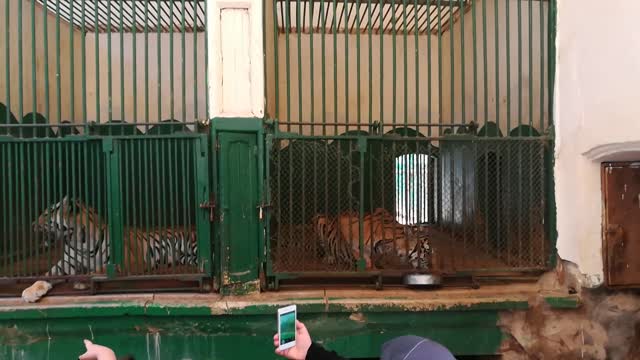Premium Only Content

Tigers in zoos
Black and white and orange all over: The beautiful, striped coat and that powerful, mesmerizing gaze make the tiger one of the world’s most revered animals. It’s a reverence that’s mixed with a bit of fear, an appropriate reaction to a large, well-muscled, swift hunter with inch-long claws and 3-inch-long (7 centimeter) canine teeth.
The tiger is a stalk-and-ambush hunter, and the distinctive stripes are good camouflage in the long grass or wooded forests of their diverse habitat. Dark stripes on a pale background break up the tiger’s outline as it lies in wait for prey to come near.
Tigers can also be black with tan stripes, all white (albino), or white and tan. The “white tigers” found in some zoos are not albino but rather the white-and-tan color variation with blue eyes (true albinos have pink eyes).
There are currently six subspecies of tigers, each living in different habitats: flooded mangrove forests, arid forests, tropical forests, and taiga. The different subspecies are found in small areas of Asia, India, and Russia. The largest subspecies lives in snowy areas of Russia. The smallest and darkest subspecies is found farther south, in the jungles of Indonesia. Female tigers are always smaller than males.
Amur or Siberian tiger Panthera tigris altaica: The largest of the tiger subspecies, males can be as long as a station wagon! These tigers also have the palest orange coat and the fewest stripes, to help it blend in with its snow-covered habitat. As it lives in a very cold climate, the Siberian tiger’s coat grows longer and thicker than other tiger subspecies, and it develops a layer of fat for insulation. There are less than 400 Siberian tigers left in their home range of eastern Russia and northeastern China.
Bengal or Indian tiger Panthera tigris tigris: This is the most common subspecies of tiger and is almost as large as the Siberian tiger. Fewer than 2,500 Bengal tigers remain in their native habitat of India, Nepal, and Pakistan.
IMalayan tiger Panthera tigris jacksoni: This is the subspecies you’ll see at the San Diego Zoo. In the wild, only about 1,400 Malayan tigers remain, found on the Malay Peninsula.
Indochinese tiger Panthera tigris corbetti: These tigers are about 20 percent smaller and are darker than Bengal tigers. Less than 2,500 Indochinese tigers are believed left in the wild of Southeast Asia.
Malayan tiger Panthera tigris jacksoni: This is the subspecies you’ll see at the San Diego Zoo. In the wild, only about 1,400 Malayan tigers remain, found on the Malay Peninsula.
Sumatran tiger Panthera tigris sumatrae: Even though the Sumatran is the smallest tiger subspecies, it’s still a pretty big cat. Imagine a tiger the same length as a school cafeteria table! Its orange coat is darker than other subspecies, as it is native to dark jungle habitat on the island of Sumatra; the sides of the face have longer fur, perhaps as protection against jungle plants. The Safari Park has a small group of Sumatran tigers, but in the wild there are less than 400 remaining.
South China tiger Panthera tigris amoyensis: These tigers are slightly smaller than the Indochinese subspecies. In the 1950s, the Chinese government ordered that these tigers be destroyed because they were viewed as pests. Today, it is believed that the South China tiger is most likely extinct in the wild.
Tigers are seldom far from a water source; there are Bengal tigers that live in wet mangrove forests along the Ganges River in India. Excellent and powerful swimmers, tigers are often found during the day relaxing or waiting to ambush prey in ponds, streams, and rivers. They seek out water to swim while most cats avoid it. Tigers even have partially webbed toes and aren’t discouraged by a river if there is prey on the other side.
A tiger’s front paws are large and strong to bring down prey. The claws can be pulled inside while the tiger walks, which helps keep the claws sharp. Tigers also use their claws to mark their territory by scratching on trees. Conveniently, this also sharpens the claws.
Tigers are patient hunters and can move slowly and quietly, stalking their prey (usually hoofed animals) for 20 or 30 minutes. A tiger’s large canine teeth and powerful jaws are used to grab a prey animal by the neck and suffocate it. Tigers use their sandpaper-rough tongues to scrape the last bits of meat from the bones of a meal. A tiger makes a kill once or twice a week and eats as much as it can. Using its paws, it then covers the leftovers with grass and dirt to hide it from vultures and other scavengers. The tiger returns to the kill over the next few days for smaller snacks. In the wild, they prefer pigs and deer, while in some parts of Asia a tiger may bring down a rhino or elephant calf.
At the San Diego Zoo and the San Diego Zoo Safari Park, the tigers are fed a specialized carnivore diet, carcasses, and large bones.Going it alone: Tigers are generally solitary cats, unless a female is caring for her cubs, and maintain a home range that can be several square miles, depending on habitat and the amount of prey available; males tend to have larger territories than the females.
The Siberian tiger has the largest range (more than 4,000 square miles or 10,000 square kilometers have been recorded) as food is scarcer, so the tiger has to travel farther to secure a meal. Some tigers defend their territory from other tigers while others often share their range.
A female tiger in estrus leaves urine “messages” on trees and other places to let males know of her reproductive status. Through loud moaning calls, a male and female can find each other for breeding and may stay together for a few days before going their separate ways. Tiger cubs are born small and helpless, but the mother must leave them alone while she hunts.
A female can have a litter of up to seven cubs every two years. In the wild, the mother could not kill enough prey to feed so many hungry cubs, so usually only two survive. At eight weeks old, cubs join their mother when hunting, and at six months they are ready to learn how to kill cattle, deer, and pigs.
Cubs seem to know from the start that they are tigers and practice their hunting skills with each other in what could be considered a form of extreme tag, since the cubs chase, tackle, and wrestle each other, growling ferociously all the while. They often practice ambush skills on their resting mother! Most tiger cubs are weaned when they are about five or six months old, but they usually stay with their mother for about two years and don’t hunt on their own until they leave. Yet up to half of tiger cubs born do not survive their first year, succumbing to starvation, disease, competition with other species, accidents, and injuries while hunting.
Although not as social as lions, tigers vocalize more frequently and have a wide range of vocalizations, including roars, grunts, hisses, and chuffles. A roar is made when challenging other tigers at long range, defending a meal, or attracting a breeding partner; a chuffle is a friendly greeting, usually used between a mother and her cubs. Other forms of tiger communication include spraying urine, leaving piles of feces where they can be seen, and clawing trees or the ground—all to say “this area is mine!”
Mesmerizing and gorgeous, but also endangered, our tigers are always a pleasure to watch. Over the years, we have had over 100 Bengal, Siberian, Sumatran, and Malayan tigers born at our two facilities. The San Diego Zoo is currently home to three male Malayan tigers. The San Diego Zoo Safari Park is home to male Sumatran tigers Denver and Rakan; and females Diana, Majel, Joanne, Cathy, and Debbie.
Our most famous tiger was Blanca, the white Bengal tiger who came to the San Diego Zoo after being confiscated as a cub by the U.S. Customs Service—she was traveling from San Diego to Mexico in the back seat of someone's car! While her owners explained to officials that the cat was returning to a private zoo in Mexico, young Blanca (she was under three months old at the time) was romping in the back seat and peering out the car's windows. Because special permits are required to transport tigers, the tiger cub was confiscated.
However, with no facilities to keep a tiger, the Customs Service temporarily relocated the cub to the San Diego Zoo's own Children's Zoo, where she soon became a favorite of guests and employees. In March 1992, she officially became part of the Zoo family. In 1996, she moved to the Safari Park, where she continued to thrive and delight guests with her unusual beauty until her passing in 2012.
Tigers at the Zoo and Safari Park receive a hearty meat-based diet, imaginative enrichment items, and basic behavioral training for husbandry. For example, our tigers are taught to “rise up” on their hind legs to allow staff to inspect their bellies and paws, they learn to open their mouths so we can ensure their teeth are healthy, and they accept blood draws from the base of their tail for laboratory analysis. All this minimizes stress on the animals in the long run, since they do not have to be tranquilized for a trip to the veterinary hospital for every health issue.
Scent is also important to tigers, and it is sometimes used as enrichment, keeping the cats engaged in their environment. Scents include donated perfumes and different herbs and spices, which are dabbed onto burlap sacks or sprinkled in their bedrooms, and the cats joyfully roll around on the scents for hours.
The Safari Park's state-of-the-art Tiger Trail features forest clearings, tiger viewing areas, and a pool for the cool cats. Tiger Trail also plays an integral role in the conservation of Sumatran tigers. We have had 27 Sumatran tigers born at the Park. Scientists estimate this tiger subspecies could be extinct in their native Sumatra by 2020 unless drastic measures are taken to protect and preserve them. Watch the Safari Park's tigers daily on Tiger Cam!
-
 8:51
8:51
Misha Petrov
17 hours agoDisney’s Snow White DISASTER - Will They EVER Learn?
5.88K17 -
 31:46
31:46
The Rich Dad Channel
1 hour agoYou Have Less Than 6 Months to Prepare for What’s Coming - Robert Kiyosaki, Bert Dohmen
5.2K1 -
 1:08:00
1:08:00
Russell Brand
3 hours ago5 Years Late: NYT Admits We Were Lied to About COVID! – SF556
161K81 -
 2:01:38
2:01:38
Nerdrotic
5 hours ago $5.78 earnedThe M-She-U is OVER and Marvel DUMPS Women - Nerdrotic Nooner 476
57.6K2 -
 1:06:57
1:06:57
Ben Shapiro
3 hours agoEp. 2167 - MORE TRUMP WINNING: NPR CEO IMPLODES, MS-13 Head ARRESTED
36K26 -
 58:33
58:33
The Tom Renz Show
2 hours agoRogan & Musk on Vaccines & Chemtrails - Are They For Real?
11.7K14 -
 1:01:08
1:01:08
Timcast
4 hours agoMasked ICE "DISAPPEAR" Anti Israel Protester Migrant, Democrats FURIOUS Over Ice Deportations
188K201 -
 2:05:00
2:05:00
Steven Crowder
6 hours agoWhat Trump’s Massive Auto Tariffs Are Really About | Guest: Bill Richmond
462K440 -
 2:25:42
2:25:42
Right Side Broadcasting Network
6 hours agoLIVE REPLAY: Congress Holds Hearing: “INL Should Fight Crime, Not Fight Conservatives” - 3/27/25
56.9K15 -
 1:06:55
1:06:55
TheAlecLaceShow
5 hours agoGuests: House Majority Leader Steve Scalise & Rep. Michael Guest | Signalgate | The Alec Lace Show
27.3K1